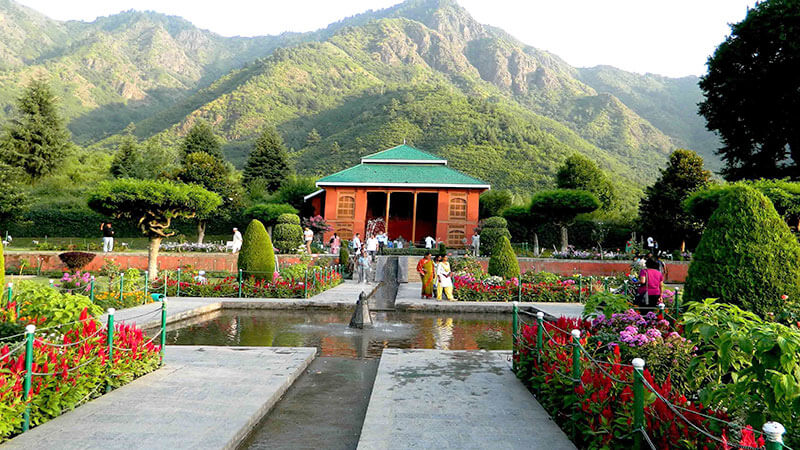Kashmir is known for its natural beauty, with its snow-capped mountains, serene lakes, and lush green valleys. However, the state also boasts of some magnificent man-made wonders, one of which is the Mughal Gardens. Located in the heart of Srinagar, the Mughal Gardens are a series of gardens that were built during the Mughal era, and have been a major tourist attraction for years. Let’s take a closer look at these gardens and their history.
History of Mughal Gardens in Kashmir
The Mughal Gardens were built by Mughal emperors during their reign in India, including Jahangir and Shah Jahan. The gardens were designed to reflect the Islamic concept of paradise, which was described in the Quran. These gardens were built in various parts of India, including Delhi, Agra, and Kashmir.
The Mughal Gardens in Kashmir are a series of three gardens, namely, Shalimar Bagh, Nishat Bagh, and Chashma Shahi. Shalimar Bagh, which is the largest of the three gardens, was built by Emperor Jahangir in 1619. The garden was initially named ‘Farah Baksh’ (Delightful Garden), but it was later renamed ‘Shalimar Bagh’ (Abode of Love) by Emperor Shah Jahan. Nishat Bagh, which is the second-largest garden, was built by Asif Khan, brother-in-law of Emperor Jahangir, in 1633. Chashma Shahi, the smallest of the three gardens, was built by Emperor Shah Jahan in 1632.
Architecture and Layout of Mughal Gardens
The Mughal Gardens are renowned for their stunning architecture and layout. The gardens are built on a series of terraces, with each terrace featuring a different variety of plants, flowers, and trees. The gardens are designed to give visitors a sense of tranquillity and serenity, with the sound of fountains and cascading water adding to the ambiance.
Shalimar Bagh is built in the Persian style of gardening, which emphasizes symmetry and balance. The garden features four terraces, with the first three terraces featuring fountains, water channels, and pavilions. The fourth terrace, which is the highest, features a large pavilion that overlooks the entire garden.
Nishat Bagh, on the other hand, is built in the Mughal style of gardening, which emphasizes the natural landscape and the use of water bodies. The garden features twelve terraces, with the first terrace featuring a large fountain and the remaining eleven terraces featuring cascading water channels.
Chashma Shahi is built in the Kashmiri style of gardening, which emphasizes the use of natural springs and water bodies. The garden features a natural spring that feeds a small water channel, which flows through the garden.
Attractions in Mughal Gardens
Apart from the stunning architecture and layout, the Mughal Gardens are home to several attractions that are worth visiting. These include:
- Fountains and Water Channels: The gardens feature a series of fountains and cascading water channels that add to the ambiance and beauty of the place.
- Pavilions: The gardens feature several pavilions that were used by the Mughal emperors for relaxation and leisure. These pavilions are intricately designed and feature stunning artwork and carvings.
- Plants and Trees: The gardens are home to a variety of plants, flowers, and trees, including chinar, almond, apple, and cherry. Visitors can enjoy the aroma and beauty of these plants and trees as they explore the gardens.
- Viewpoints: The gardens feature several viewpoints that offer stunning views Apart from the beautiful gardens and architecture, Mughal gardens also have a rich history associated with them. The Mughal rulers were known for their love for gardens and greenery, and they left behind a legacy of magnificent gardens in the Kashmir Valley.
The construction of Mughal gardens in Kashmir began in the 16th century when the Mughal Emperor Akbar visited the valley. The construction of Shalimar Bagh was started in 1616 by Jahangir, the son of Akbar, and completed in 1620. The garden was named after his wife Nur Jahan, who was also known as Shalimar.
The Mughals continued to build gardens in the valley over the next few centuries. In the 17th century, Shah Jahan, the Mughal Emperor who built the Taj Mahal, built the Nishat Bagh and Chashme Shahi gardens. Nishat Bagh, which is known as the “Garden of Joy,” was built in 1633, and Chashme Shahi, which is known as the “Royal Spring,” was built in 1632.
The gardens were not only a place of leisure for the Mughal rulers but were also used for official purposes. The gardens were used to hold royal receptions, as well as for political meetings and negotiations. The Mughal rulers would also use the gardens to discuss matters of state with their advisors and ministers.
Apart from their historical significance, the Mughal gardens in Kashmir are also a significant source of income for the local economy. The gardens attract a large number of tourists from all over the world, and the tourism industry provides employment opportunities for the local population.
In recent years, the Mughal gardens have faced some challenges. The excessive use of pesticides and fertilizers in the gardens has led to soil degradation, and there have been reports of soil erosion and landslides. The government has taken steps to address these issues by implementing sustainable gardening practices and promoting eco-tourism.
The Mughal gardens of Kashmir are not only a testament to the love of nature and beauty of the Mughal rulers but also an example of the rich cultural heritage of the Kashmiri people. The gardens serve as a reminder of the rich history and traditions of the region, and a symbol of hope for the future of the valley.
In conclusion, the Mughal gardens of Kashmir are a must-visit destination for anyone who loves nature, history, and architecture. The gardens offer a glimpse into the rich cultural heritage of the region, and the lush greenery and beautiful flowers make it a truly enchanting experience. Whether you are a history buff, a nature lover, or simply someone looking for a serene and peaceful escape, the Mughal gardens of Kashmir are sure to leave you spellbound.



